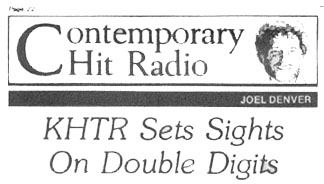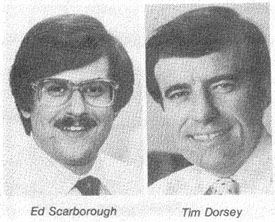|
|
PD
Scarborough Says: "Not A Fad;" |
|
| When Mike Joseph started "Hot Hits" rolling, he knew he had a good thing. As with anything successful, others have grabbed hold for the ride to ratings and revenue. KHTR/St. Louis is an example of a station using many of Joseph's principles while learning from the experiences of CBS O&O sister stations WCAU-FM/ Philadelphia and WBBM-FM/Chicago, which both ran the Hot Hits format and subsequently modified its all-currents approach to include recurrents and a few oldies as well. | |
|
"I was appointed PD while KMOX-FM was still a background A/C station, and in August of 1981 we began an ever-so-slow transition toward CHR." Ed points out that it was more than just the philosophy of emphasizing currents which made the difference. "St. Louis, like a few other major markets, was primed for someone to fill a gaping format void created when the rush to go A/C was in full swing." |
|
Filling A Hole Sparked by the success of WCAU-FM and WBBM-FM, KMOX-FM decided to do its own version of 'Hit Radio.' "It was almost two years since KSLQ decided to go A/C, completing the effort by shedding those teen-oriented calls in favor of KYKY," recalled Ed. "The hole was almost big enough to drive a truck through, but no one wanted to fill it. We finally realized that you can only share that A/C pie so many ways." Tim went on to say, "The process of going CHR took almost a year and was complete in August 1982, just after malting a visit to WBBM-FM. At that time we were only playing six currents an hour, but right after the trip Ed jumped that to about 11." He drew an interesting analogy: "It's like taking a successful Broadway show on the road. It worked in Philadelphia, was a smash in Chicago, so why not St. Louis? we asked. KHTR really benefitted by their mistakes and from the positive ends of our sister stations' experience with a CHR format." Ed
admitted, "We had straddled the fence for a long time, and agonized over songs that
were too hard or too soft for us. We decided that if John Cougar had a hit record, then we
were going to play it instead of rationalizing if songs were too extreme for us to deal
with. At that point in our minds we made the jump to CHR."
Spreading The Word Perhaps the most amazing aspect of KHTR's success was that the numbers in the first book "were simply attained by word of mouth," as Tim remarked. "We hadn't changed our calls, but we |
|
| During a candid conversation with PD Ed Scarborough and Station Manager Tim Dorsey (who have been in St. Louis for a combined total of 14 years), I was able to learn how they went about building a powerful new image for a previously colorless station. Along the way, both gentlemen shared some interesting thoughts on contests, music, and the CHR format in general.
KMOX-FM To KHTR |
|
"My primary concern is that the station sounds consistent in the morning, afternoon, and at night. If we aren't, then the people that tune in for one thing willhear something they're not expecting in another daypart and we'll end up satisfying very few in the long run." |
|

